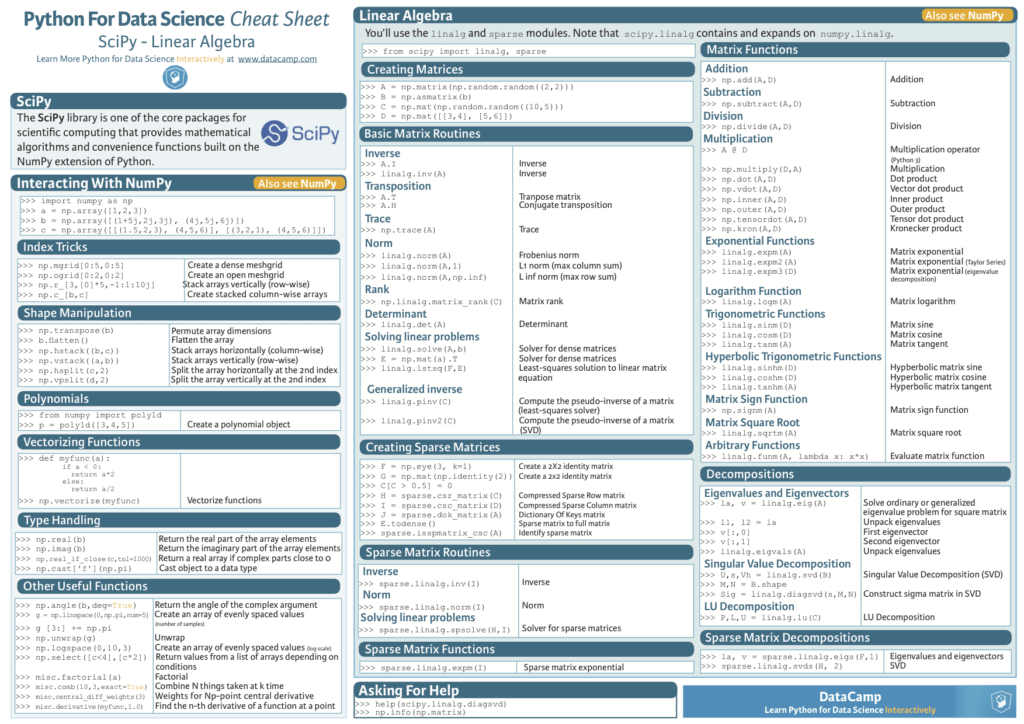
Python SciPy is a robust library for scientific and technical computing, providing efficient numerical routines for optimization, integration, interpolation, linear algebra, and statistics. It complements NumPy, enabling advanced mathematical operations and algorithms for diverse applications.
SciPy is a powerful scientific computation library in Python which provides robust tools, numerical and scientific computing capabilities for Linear Algebra.
Table of Contents
Introduction
Python is a widely used programming language that is well-known for being easy to understand, readable, and flexible. One of the areas where Python shines is scientific computing, thanks to libraries like SciPy. SciPy is a powerful open-source library that provides a vast collection of user-friendly and efficient numerical routines, such as routines for numerical integration, interpolation, linear algebra, and statistics.
In this post, we’ll explore the ultimate cheat sheet for SciPy, covering its core modules and functions that will help you tackle a wide range of scientific and engineering problems with ease.
What is SciPy?
SciPy is a powerful scientific computation library in Python, designed to enhance your numerical and scientific computing capabilities and provides robust tools for linear algebra. Let’s explore its key features:
Definition
- SciPy stands for Scientific Python.
- It builds upon NumPy and provides additional utility functions for various scientific tasks.
SciPy Fundamental Algorithms
- It provides a rich collection of algorithms for various scientific tasks, including:
- Optimization: Solving optimization problems.
- Integration: Numerical integration techniques.
- Interpolation: Fitting curves to data points.
- Eigenvalue Problems: Analyzing matrices.
- Algebraic Equations: Solving equations.
- Differential Equations: Modeling dynamic systems.
- Statistics: Statistical functions and distributions.
- Signal Processing: Offers tools for filtering, Fourier transforms, etc.
SciPy Core Modules
1. Constants
scipy.constants: Provides physical constants like speed of light, Planck constant, and more.
2. Linear Algebra
scipy.linalg: Linear algebra operations like solving linear systems, singular value decomposition, and more.
3. Interpolation
scipy.interpolate: Interpolation functions like 1-D spline, polynomial interpolation, and more.
4. Integration
scipy.integrate: Numerical integration routines like quad, dblquad, odeint, and more.
5. Special Functions
scipy.special: Computes special mathematical functions like Bessel, Legendre, and more.
6. Signal Processing
scipy.signal: Signal processing tools like convolution, filtering, and more.
7. Sparse Matrices
scipy.sparse: Data structures and functions for sparse matrices.
8. Statistics
scipy.stats: There is an expanding collection of statistical functions in addition to continuous and discrete probability distributions.
9. Optimization
scipy.optimize: Functions for minimizing (or maximizing) objective functions, including solvers for linear programming, non-linear programming, and more.
10. File I/O
scipy.io: Input/Output functions for working with various data formats like MATLAB, IDL, and more.
11. Fast Fourier Transforms
scipy.fft: Fast Fourier Transform functions for numerical recipes.
12. Clustering
scipy.cluster: Clustering algorithms like hierarchical clustering, K-means, and more.
13. Spatial Data Structures
scipy.spatial: Spatial data structures and algorithms like KDTree, Delaunay triangulation, and more.
14. NDImage
scipy.ndimage: N-dimensional image processing functions like filtering, morphology, and more.
Broad Applicability
- The algorithms and data structures in it are widely applicable across different domains.
- Whether you’re working on physics simulations, financial modeling, or bioinformatics, it has tools to assist you.
SciPy: Built on NumPy
- It builds upon the foundation provided by NumPy (Numerical Python).
- It extends NumPy by adding specialized data structures (like sparse matrices) and additional tools for array computing.
Performance and Flexibility
- It wraps highly optimized implementations written in low-level languages such as Fortran, C, and C++.
- You get the flexibility of Python combined with the speed of compiled code.
SciPy: Ease of Use
- It’s high-level syntax makes it accessible to programmers of all backgrounds and experience levels.
- Whether you’re a seasoned developer or a beginner, SciPy simplifies complex scientific computations.
Open Source and Community-Driven
- Like NumPy, it is an open source, allowing free usage.
- Created by Travis Olliphant, the same person behind NumPy.
- Developed and maintained publicly on GitHub, SciPy is distributed under a liberal BSD license.
- Its vibrant community ensures continuous improvement and responsiveness.
SciPy: Language Written On
- Predominantly written in Python, with some segments in C
SciPy Cheat Sheet

Summary
In summary, SciPy empowers Python developers and capabilities with a toolbox of scientific algorithms and data-related tasks, making it an indispensable companion for researchers, engineers, and data scientists alike. This cheat sheet should serve as a handy reference for leveraging the power of SciPy in your Python projects. Whether you’re working on scientific research, data analysis, or engineering problems, SciPy provides a comprehensive toolbox to help you tackle complex computations and data manipulations with ease.
Keep in mind, it is just a tip of the iceberg. SciPy is a vast library with numerous modules and functions, so be sure to explore the official documentation for more in-depth information and examples.
Learn more about related topics
- Algebra Calculus
- Data Science Cheat Sheets
- Probability and Statistics
- Deep Learning Cheat Sheets
- Learn more about SciPy on it official website
